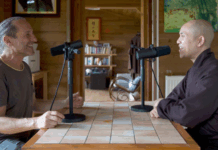February 19, 2019

Wake Upper Marek from Poland is a passionate cook and currently serves the Sangha in Plum Village as the kitchen coordinator in Son Ha, one of the monks’ residences. In this interview, he shares practices to bring mindfulness into the kitchen and a diet that serves ourselves as well as our planet.
Q: You have been co-responsible for leading cooking teams at Wake Up Earth retreats since 2016. Can you share about your experience of cooking for more than 500 people with a team of volunteers?
Marek: It’s been a very good experience. I’ve learned about how to be with myself and how to work with loving human beings together in the kitchen with the same aspiration: to make big amounts food on time (laughs). I’ve also learned to cope with challenges that come our way.
In terms of practicing in the kitchen, we start with a body scan and invite the bell regularly throughout the cooking sessions. That is a wonderful way to unite the group and tune into the present moment. Generating breaks is important to ensure that we support each other. It is a practice of being ready to let go and embracing the situations as they come up.
Q: Cooking often means multitasking. How do you manage to stay present?
M: To stay present to everything available in the moment is quite impossible. However, the preparation helps to have a grounded space within myself, to accept what is in the present moment, and to share openly with others. I practice with generating pleasant feelings within my own body because this is what I can return to. What I find beneficial too are my regular physical practices like Tai Chi or Qi Gong.
Q: How can we nourish our joy through cooking and eating?
M: This is a bigger question. I only hope not to mislead anyone. To me it seems that nourishment can be joy, and joy can be nourishment. It is being alive, the river of the present moment—how can we enter that zone? It is not something that we can manufacture. If we cannot touch it, we may need to adjust the way we look and go beyond our fullness with the known.
How do we do that? Thay says that one step, one breath is enough, so he is pointing to a quality. If we try to cook or eat from a “head” space of “the known” and bringing our past into the present, then we limit space for life. That is nourishment and joy, and they may arise spontaneously; let’s welcome them in. I also say that to be orientated towards joy, and nourishment is good in itself. Poet Rumi once said: not only the thirsty seeks the water, the water as well seeks the thirsty. Let’s be available to this then.
Q: Nowadays, there is confusion about foods that are good for our body. What are your thoughts on finding the foods that serve us?
M: Yes, there is a lot of information, and that can be confusing. To find out the foods that are good for our body, I think it’s reasonable to assume that we need to be in touch with our body and not what we think about it, though this may inevitably be there too. In each moment, the body is giving us information in form of sensations. Can we accept them? What are the sensations communicating to us?
This is an invitation to go beyond the ideas of what is good for us and try to act with food purely from that loving space. Once we tune into our body as our home, then we may naturally be loving towards it, and our body will find its ways to communicate. Let’s learn our body’s language. We may ask our body: tell me what is healing to me now? Let the body answer.
We may want to experiment by eating foods considered healthy, and let the body give us feedback. I am not there yet myself, so good luck on your quest [smiles]. One thing, for example, to watch out for is: am I eating to nourish life and vitality in me and in the world, or am I eating to numb myself or push life away?

Q: Do you have advice for those who may feel a lack of ideas when preparing a meal? How can we bring more creativity into our cooking while keeping the recipes simple?
M: Yes, if you feel stuck, maybe you are trying to get a perfect result? Let the body tell you; let genuine curiosity guide you, and you may be part of creating something intimate to you. Then try not to judge it with the mind; just remain open to learning.
Here is another way: imagine you serve yourself a bowl of simple foods, like rice or other grains, steamed broccoli, carrot, spinach, simple well cooked beans, some type of raw, or fermented vegetables. Have your condiments at hand on the table, such as salt, pepper, some spice you like—maybe ground seaweed, toasted seeds, lemon juice, or cold pressed oil. But don’t have too many choices. Begin to eat one thing at a time. Then start mixing the ingredients randomly and taste how they work together. Then add a condiment that inspires you. Note the ideas that come up; have fun.
Q: Do you have tips for veganizing one’s diet, especially when someone is having a hard time replacing animal products they like to eat?
M: The way I see a vegan way of eating is to begin enjoying simple things. It’s good to be aware we may never eat something that tastes like the animal product we’ve been used to, so it’s good to have reasonable expectations. If we think of cheese, pick one kind you like and recreate that in the kitchen, like parmesan. One way is to use nutritional yeast, add quite a bit of unrefined salt, and perhaps a bit of some mellow herb, like marjoram or parsley and ground up nuts (try almonds, brazil nuts, or seeds). It may not taste like real parmesan, but for me it does. I like feta cheese or cottage cheese, so I like using cashews. I first soak them, cream them, and then introduce probiotic bacteria and let it do the job until it gets bubbly and sour. Later, add salt and some herbs like dill or chives.
In regards to meat, what do you like mostly about it? Is it the texture? How filling it is? The flavor? One of the ways to imitate chicken is to fry tofu. A variety of beans is important. They always need to be soaked at least overnight. Once cooked, they can be dressed with olive oil, for example. I like fried beans because they are filling. A good sourdough bread is also important in the transition. Try not to omit ‘umami’ flavor, like rich tomato sauce, roasted or sautéed mushrooms, soya sauce, miso, tempeh, kimchi, or herbs. Your body may strongly ask for it.
I try not to think, “It should taste like xyz.” There is a whole world of plant-based foods, and we have to be open to new flavors and subtleties and plain organic vegetables. Maybe we will taste a carrot like we never tasted it before. Maybe brown rice or spelt with just some herb and salt will be enough to truly nourish us. We don’t need to go to the memories of having this and that. But if we get these cravings, then the things I mentioned could be a helpful transition.
However, nothing will replace listening to our body. If sometimes we feel like we can’t do without meat or dairy, then there is no point in beating ourselves up for actually eating that. Instead, we can appreciate Mother Earth and the animal that has given its life for our cause and recognize we are doing our best.
For most people, it may be good to transition slowly by reducing animal products and sugar, using good fats, and fermented foods. Changing an environment to a more vegan friendly environment will be of help.
Interview conducted by Annica


















